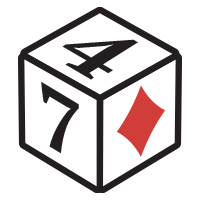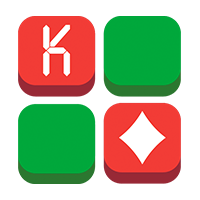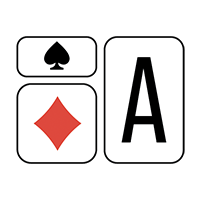Fedor Holz: I picked a few different hands that were interesting. Charlie, are you ready?
Charlie Chiu: Yeah, totally.
Hand #1
FH: This is a kind of special hand because it seemed quite straightforward, but the small blind has just been eliminated so we have a single big blind. I mean big blind posts the big blind ante, so the small blind is missing.

And now, Loon is raising off a 20 BB stack and I'm in middle position and I'm second in chips and I have .
So first of all, his strategy, some ideas around that with the single big blind, and then also my response. Those are the two interesting points here.
Spoiler:

I think the first thing where people will make mistakes here is maybe not playing this too wide, but like definitely never play this too wide. Probably people overpairs too much. So like, I mean, 8s is pretty close already. So just generally playing the spot pretty tight. There's just not so much to gain. So that's the starting point.
How do we react to this 13% raising range? I mean, generally one thing that's very important in these type of spots is, as a general rule of thumb, think about what the worst hands are that he's open-raising and then folding. These spots are very sensitive to blocker and unblocker effects.
So between and , you probably want to have more than because he raises and folds suited for example. There were some answers in very different directions. No flats. I think you can play a flatting strategy, but it would be minuscule. Generally, if you want to flat, then probably and are hand categories that you should think about and consider.
But the main hands are really those hands that dominate some of his hands as well and play just very good post-flop. s is probably the best example.
If he's opening o and s and s, and also those suited , s is just this prime hand that just dominates everything that's folding if you 3-bet.

Basically, if you build a flatting range, it probably kind of builds around s, s, s, also quite interested in that. And then s maybe less so, but could also be in there. And then you can have some pocket pairs, but those are more I think kind of frequency filling ups rather than anything else. Even sometimes hands like s are good 3-bets. It depends on the spot.
Sometimes if he goes all-in with all , then it's not that great to have . Then you're just blocking the value part of his range. But also blocks quite some value. We block , we block , that can be helpful. But it's really dependent on if, for example, he goes all-in with all suited , it just becomes slightly less relevant. But if he doesn't, then actually functions quite nicely.
CC: I've never seen this under the gun player before. So if you assume you kind of have some edge against this player, then what would you do in this kind of spot?
FH: I mean, it depends on what that means he doesn't have experience, right? Like for example, sometimes it could actually be that you want to play tighter. Because if, for example, it's a player that maybe cares less about ICM and plays more like plays a tight range, but then plays that range more aggressive post-flop, then actually you don't realize that much equity.
If you play against a player who then is like very, very scared, you know, they only bet if they have it and check-fold if they don't, you realize much more of the equity. So sometimes you are in those spots where you play against players that don't really understand the implications. And then suddenly, actually, you want to kind of avoid playing thin spots against them because they just put too many chips in the middle.
I think probably the strongest argument to make is how often they 4-bet jam. That's probably the strongest argument. Because often weaker players, they don't find the 4-bets. And that is mainly the main argument I think to make for, for example, widening your 3-betting range.
CC: Ready for the second?
FH: Yeah, let's go.
Hand #2
Fedor Holz: We have under the gun, which is 7 left. And I open raise and Seth 3x 3-bets.

So first of all, maybe, do you want to start with what should I open? I made a spoiler already.
So, folding suited ? No, no, no.

I think what you said is slightly too tight, probably.
I think we're quite too tight in suited Kings. I probably also open s, o, o, and then o, o. I make a bit dependent on the table
Cutoff's answer:

So now, okay, it's his reaction already. This is very hard to ask about, but basically I think the major thing here is to just put on quite a lot of pressure. It's probably also what a lot of players are missing, like finding the right frequency here. I would say you should probably hit at least 10% 3-bet here. And most players probably 3-bet more like 7 or 8%.
I think as long as you find roughly the right direction here, that's very important already. A really big difference between a mid-stakes and a high-stakes player is here is not very close to this. The flatting is also that important. You don't have to flat s or s, but s is quite important, realize just really good equity.
So it's just quite important to understand the dynamic of the spot and mostly find the 3-bets and general VPIP.
So if you VPIP here like 26% and 3-bet like 10%, that's very fine too. It's also quite important how people approach the spot because ICM will I think put more pressure on me than how I will play it. I don't think I'm under as much pressure as ICM would dictate. So it's not like I will play super passive.
Because the thing is, if I double against Seth, yes, there's a lot of risk premium, but I'm basically running over the table now.

UTG reaction against kind of 3-bet, I would play the spot a little differently now. But I think the point is, it's fine to be a nit here. I personally think that these shoves here are not optimal. I think that it is better to induce more here. I mean, with these ICM calculations, you want to induce less. I personally think that it's better to induce more.
So s and , I'm basically always inducing. But I think what's generally important is also o, I'm not folding. And also , I folded in the game mostly because of this particular spot we are in. Seth as the chip leader, is in an extremely good position for me.
But you mentioned s. I think that actually in these types of spots, those hands that kind of are hit or miss are quite valuable. So if you have for example, the hand plays quite straightforward.
CC: Why would you say you want to induce a little bit more than the solver does?
Because solver obviously, because our risk premium is so high, so we kind of don't want to induce and . But you say like you kind of want to induce more. Is it because you think they're going to 4-bet bluff more or something like that?
FH: Not necessarily more. Think about it like this, right? So let's say you look at a model, okay? And let's say the model looks at, okay, let's say Seth goes all-in with suited Aces, you know, a certain amount of the time. And then the model calculates the ICM value and it looks at the outputs. And it's like, okay, if you 4-bet and he jams suited , he still has, you know, a bit over 30%.
And then we're like, okay, this is the model is saying, okay, this is worth this much, you know? And if we go all-in, we like, he folds way more often and we only get called by +, basically. If that is the case, then the model is attributing more dollar value to the jam because it's like, oh, you know, it's so bad if we get it in and lose. And it's only so good if we get it in and win.
And what I'm saying is, even if you put it at the exact same percentages, so if Seth is going, you know, same percentage, if he's going all-in same percentage of suited going all-in, I'm saying that the value that the ICM model is attributing my chip stack when I double, I don't agree with that value. Because I will have 100 big blinds and there will be six stacks with like 15 to 30 big blinds. I'm probably going to be chip leader for an average of, I don't know, 30 hands or something.
So ICM is not calculating this future game. This is maybe one of the takeaways of this session. This is a very important aspect. The general tendency right now is to play these spots too tight. And I'm very, very certain about this, that we have to play the spot more for chips than this, you know, slightly more calling, slightly more 4-betting, like more inducing.
So what that means is, that your passivity in position is even worse. Because the majority of players are just playing too tight. So make sure that you find the in-position aggression.


Hand #3
A8o in the cutoff, Dimitar Danchev in the small blind.

I made a spoiler for the cutoff first in, kind of similar to before. o, , any suited, like s type of stuff.

Here's the small blind reaction. I think I did a spoiler of this one as well.
He should have small sizing with the absolute majority of his range, some all-ins, and some larger sizings.

But the main sizing is like around the 4 BB mark, four to four and a half I think that's quite a nice sizing from him.
Now, what am I supposed to do?
CC: All right, let's go again – no flatting. I'll just play pure 4-bet shove and fold. I think I'll jam a pretty linear range here.
FH: How do you get to your 4-betting range? There's a concrete reason – why do you have to go linear?
CC: I don't want to play post-flop with a low SPR.
FH: That's not the reason. I mean, the main reason is if you face a linear 3-betting range, especially when the SPR is so low, you will have to go with a linear shoving range.
So this is just purely math, where it's like, okay, you know he 3-bets quite linear, not super linear but quite linear, and then when he 3-bets linear and we're quite short, then against a linear range we just have to find the exact – there's no like, okay, you know, like polarizing. It's just literally, okay, like it's just numbers. It's just, okay, this hand has enough equity or this hand doesn't have enough equity. There's like a very clear line which hand has it and which hand doesn't.

CC: Wow, that's surprising.
FH: What surprises you?
CC: Actually shoving quite a ton. More than I thought. And we actually have a flatting range! Oh, that's very cool to see.
FH: It's a similar phenomenon as before. There's basically one or two hands that just really benefit, especially also if you think linear, there's basically like before, it's also open-raise, it's also always linear, almost always, unless you get very short, right?
So we see the same phenomenon there. There is basically one or two hands that are like right where if you raise, they fold worse and call better. And you see the same phenomenon here. And for certain hands this is beneficial and for others it's not.
So when you have so low SPR, sometimes this is for Aces, because you just want to keep hands in. And then almost always it's for suited Aces as well, where it's like, if he raises suited plus, for example suited, it's always kind of the middle, right? Like, or leaning towards the middle, where if you go all-in, like you basically isolate yourself against better, and if you call, you keep in worse.
So, the linearity is the important part.
Hand #4
Dimitar Danchev opens from the cutoff and gets 3-bet by Seth.

Cutoff opens, maybe something like this:

And then the Button's reaction:

Obviously, it's not the button reaction that is being played.
So what should I 4-bet?
I will do a spoiler of the range. I actually think this was one of the mistakes I made on the final table.

My in-game thoughts – and I'll run you through a little bit. I think it is fairly clear here that you have to go something along the lines of – I thought it would be somewhere along the lines of off, suited, eights. And again, everyone who's posting in the chat, and if you don't really know that they're on the same line, then make sure you know that. It's kind of like hands function in the same equity buckets, basically.
Yeah, so it's like off, , suited, or like off, suited, and . It's a bit depending on your opponent's range, but they're always kind of in the same bucket.
In my thought process, I thought that Seth would go more equity-driven and less polarized. And now basically I was thinking, okay, like how does that change my range?
I think I made a wrong adjustment here. I think is just very clearly a shove. If I have something like off, like I probably always fold, and I think that's fine. And I probably just go something like, I mean for sure plus, , suited, and then think with like suited and off and .
Hand #5
I'm in the hijack. UTG 5-handed, basically.
So my idea here was that there is still some room, also it reduces flats by quite a bit, because if it goes flat, big blind can go all-in basically, and the pot is reopened, and it's kind of the optimal size.

I thought between like raising big and charging him the most possible, and having the opportunity to reopen a pot. So I quite liked it.
Now big blind defends against 2.5x. So purple is all-in, which is just extremely linear. The rest is fairly tight. I mean, we VPIP like against like a UTG range.

Hand #6
All right, three left.
So, small blind strategy. This one is going to be very difficult.

So, Charlie?
CC: I think the first thing I would think is like, do we have a flatting range here with this stack-to-pot ratio? Probably not that much. I probably would play like mostly raise-fold and all-in strategy.
FH: You said almost no limping. Why is that? What would you do, for example, with ?
CC: Raise, probably 2.5x maybe.
FH: What would you do with suited?
CC: I think I'll jam. You can fold out better-dominated combos. So it'll be like the medium part. I'll just jam
FH: And what do you do with suited and offsuit?
CC: I think I'll raise-fold as well
FH: But I would really challenge you also to really try to understand, because it's going to be much easier to summon a structure of a range if you understand the dynamics better. Because here, generally what I'm assuming from what you said is that you play this spot based on ICM, where there's probably more than three players left, and you looked at something like similar stack sizes.But now it's like four, five, six players left, play much more for chips in the spot here.
There's a lot of ante in the middle, right? I'm not sure if you if you have considered this, but obviously, this is a very different sim if you have a big blind ante and you have three left. There's like a lot of money in the middle. You want to VPIP as much as you can.
And then basically there there's like two big forces here. And the two big forces are basically one, we want to push him off a lot of equity paired with value, and the other one is realizing as much of the pot as we can.
So the two ideas here are around limping a lot, just because we cause 0.5 big blinds and then there's a 3 big blind pot. So very little big blinds for actually a pretty big pot. And that's why we want to limp a lot.

I pushed, and Dimitar thought with .

So yeah, one thing that's quite interesting here is the moment you start adjusting this to what people actually jam, you will play really tight in the spot. I would probably say that anything that's like plus 15, like plus 0 or worse, I fold against almost anyone, except like strong pros where I know they shove correctly.
The absolute majority of players do not find the weak jams.
Hand #6
All right, you ready for the last hand?
Heads up with big blind ante, and we have 10 big blinds. Are you ready?

CC: I think you have to VPIP almost 100%. And we have quite a lot of limping, probably play a limp and all-in strategy. And this hand category is always limp-call.
FH: When we try to go with logic, I think these pillars will just really help you break down faster.
So basically the main thing what you will see here is obviously you can go all-in with a lot. We know we know this because there's a lot of chips in the pot. Basically what you will see is, as you mentioned, we will VPIP almost 100%. We will probably not VPIP, let's say maybe the bottom 5% or so.
And now we have to find the right balance between all-in and weak VPIP. And we are in a position where we will probably have a good enough range to select quite well. And when we can do that, then we just take basically the best hands to do either. And that actually leads to our range looking very structured.
So what you will see is, in this particular spot, like if I try to think about it, then I would see, okay, I VPIP probably 95%. And I think what will happen is, if you visualize it
So there's like this little thing on the side where we limp that and then all the rest there shoves, like , . That's going to be close between limp and shoving, but like suited we limp call. And you know, so it's like you have to slide, and then if you shove, like you know maybe like suited is a limp call as well, or like you know maybe suited or like suited as limp call. But if you shove that, you know that's not going to be so.

As long as you establish this line where okay, you have all the hands to the left basically are limps and all the hands to the right are jams that are like fine decent enough, you identified that. So now from this already you have this part solved.
And now the offsuit part is also even easier. When the offsuit part is basically anything like there it looks like this – anything that's strong enough is a jam, almost basically up to the strongest hand, any , any , any , and then goes to probably like that's where the where the curve starts.
Fedor limped, Seth moved all in, Fedor called and won.

















